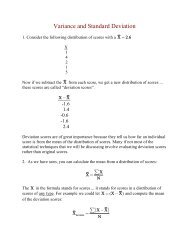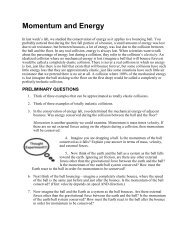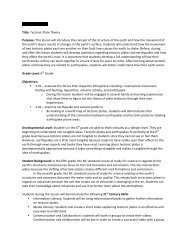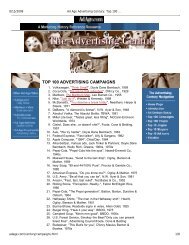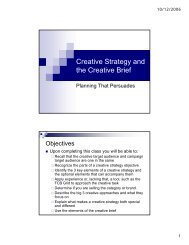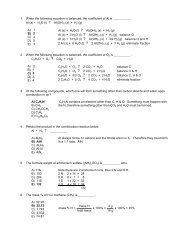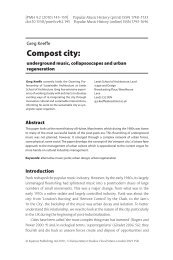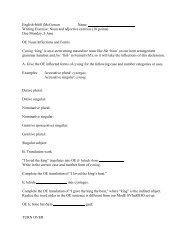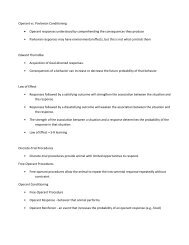Competing Ads.pdf - MFC home page
Competing Ads.pdf - MFC home page
Competing Ads.pdf - MFC home page
Create successful ePaper yourself
Turn your PDF publications into a flip-book with our unique Google optimized e-Paper software.
Advertising Age<br />
http://adage.com/printarticle_id=116722<br />
Why Big Brands Are Getting Into the Ring<br />
As More Products Hit Market, Diet Coke, Other Titans Embrace Tactic Traditionally Employed<br />
by Upstarts<br />
By Kate Macarthur<br />
Published: May 22, 2007<br />
CHICAGO (AdAge.com) -- The gloves also have come off for advertisers, and it's not just the upstarts taking swings.<br />
The challengers in this round of comparative ads are far from the usual small-time players in esoteric categories.<br />
Increasingly, the jabs are coming from industry giants such as Pizza Hut, Diet Pepsi, Apple and Subway. You can take<br />
your pick of causes: product clutter, category maturity, executive turnover or activist investors. But one reason beats all.<br />
To unveil the makeover of its<br />
43-year-old Diet Pepsi brand,<br />
PepsiCo revived its famed "Pepsi<br />
Challenge." It uses pop-culture<br />
references to tout that 56% of<br />
consumers said Diet Pepsi has<br />
more cola taste than its archrival.<br />
"Because it's effective," said Z. S. "Andrew" Demirdjian, professor-marketing at California State University at Long<br />
Beach, Calif. "It would [result in] at least a 20% increase in sales if properly done," he said.<br />
'Category shorthand'<br />
In a world where the explosion of brands has made the majority of products look like me-toos, comparative ads give<br />
consumers a logical decision factor. Despite declarations that consumers are in control, "most consumers don't want to<br />
make decisions," said Tony Pace, chief marketing officer for Subway's Franchisee Advertising Fund Trust. He said<br />
using "buy our sandwich instead of their hamburger" messages provides "category shorthand" for consumers.<br />
And as brands become more adept at making tit-for-tat product tweaks, what once were points of difference have<br />
become commoditized. So, like bored cocktail-partiers turning to the local forecast to break the silence, marketers are<br />
taking otherwise small differences and blowing them up to stay in the conversation. You want clean tables Eat here!<br />
Calls that don't drop Sign up for our service!<br />
For years, fighter brands outspent by goliaths have aimed their marketing slingshots at the big guys. But the internet and<br />
the burst of public offerings have leveled the playing field for newcomers. So whereas once share leaders rarely stooped
Advertising Age<br />
http://adage.com/printarticle_id=116722<br />
to acknowledge follower brands, today some are taking on multiple rivals -- even those in adjacent segments such as<br />
Miller Lite vs. Bud Light and margaritas and wine. Coca-Cola Co. has even taken on itself, pitting its Coke Zero against<br />
its flagship Coke Classic.<br />
Big guys step up<br />
Since consumers overwhelmed by brand choice search for information, it's tempting for marketers to help the process<br />
along. For all the talk of brand loyalty, only 8% to 10% of people are stubbornly brand loyal, said Arjun Sen, president<br />
of Restaurant Marketing Group, who has helped several brands develop comparative claims, including Papa John's.<br />
"There is a huge group of people who can be swayed. Now that the market is saturated, it's a new move for big guys to<br />
say 'I'm going to take you out today.'"<br />
His research has showed that comparative ads, properly executed, can boost sales 15%.<br />
There is, of course, another side effect: More complaints are expected to swamp the ad industry's self-regulatory body,<br />
the National Advertising Division of the Council of Better Business Bureaus, though the NAD said its caseload of<br />
competitive challenges has held steady so far.<br />
"It's the nature of public discourse now," said John Villafranco, a partner at law firm Kelley Drye. "We're likely to see<br />
more battles in court and the NAD and other places about truthfulness of the claims."<br />
Other Categories Where Battles Are Brewing<br />
DIET COLA<br />
To unveil the makeover of its 43-year-old Diet Pepsi brand, PepsiCo revived its famed "Pepsi Challenge." It uses<br />
pop-culture references to tout that 56% of consumers said Diet Pepsi has more cola taste than its archrival. The spots use<br />
fuzzy math and silly verbal qualifiers to dramatize the point; one claims three of five "90210" characters would choose<br />
Diet Pepsi, generously rounding up to 60%. Another mischievously stretches the truth, saying 56% means "everybody.<br />
OK, almost everybody. Mostly everybody. Fine, a little more than half of everybody."<br />
PIZZA<br />
Challengers have been pig-piling on Pizza Hut with deep discounts and quality claims for years, but the Yum Brands<br />
segment leader fought back with a New Year's Day campaign saying consumers preferred its hand-tossed pies 2 to 1<br />
over both No. 2 Domino's and No. 3 Papa John's. The "America's Favorite Pizza" spot showed rival delivery drivers<br />
eating pizza at the <strong>home</strong> of the Pizza Hut driver. Papa John's earlier this month added a new PR claim: Its dough is made<br />
fresh, while Pizza Hut's is frozen. Yet the battle isn't doing much to draw new consumers. In 2006, Papa John's share<br />
grew 7.8%, more than making up for the combined 6.1% share lost between Pizza Hut and Domino's. But growth among<br />
the top chains was half that of the growth of independents.
Advertising Age<br />
http://adage.com/printarticle_id=116722<br />
Eager to regain the sales boom Miller Lite enjoyed before the Man Laws misstep, Miller Brewing Co. is going back to<br />
challenger-brand mode -- this time with Anheuser-Busch's Bud Light, Heineken Premium Light, and even margaritas<br />
and white wine. Homemade spots that look like they were pulled from a marketing presentation will compare calories<br />
and carbohydrate levels. Our advice: Look out for a sales sucker punch from the spirits and high-sugar,<br />
energy-drink-based cocktails hot with 20-somethings.<br />
FAST FOOD<br />
Subway has faced comparisons by No. 2 sandwich chain Quiznos, but the Doctor's Associates-owned chain is zeroing in<br />
on a bigger target: McDonald's. The sandwich leader's spots boast that its foot-long Subway Club has less fat and more<br />
meat than the Golden Arches' Big Mac. Despite the growing penchant for big burgers, it's lucky for McDonald's that<br />
Subway doesn't have many drive-thrus, as sandwich-category growth was double that of the hamburger chains in 2006.<br />
COMPUTERS<br />
By tapping the emotional badges of hipsters vs. geeks to dramatize features and functions, Apple's spots comparing<br />
Macs and PCs have elevated the comparative ad to a whole new level. It seems to be working, as domestic Mac share<br />
growth outpaced that of its three larger rivals in 2006 and during the first quarter with a 30% pop, according to IDC and<br />
Gartner. But Mac still controls only about 5% of the market, and PC users have gotten some revenge spoofing the iconic<br />
ads on YouTube.<br />
~ ~ ~<br />
Contributing: Alice Z. Cuneo<br />
Copyright © 1992-2007 Crain Communications | Privacy Statement | Contact Us



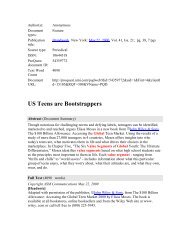

![Graduate Bulletin [PDF] - MFC home page - Appalachian State ...](https://img.yumpu.com/50706615/1/190x245/graduate-bulletin-pdf-mfc-home-page-appalachian-state-.jpg?quality=85)
